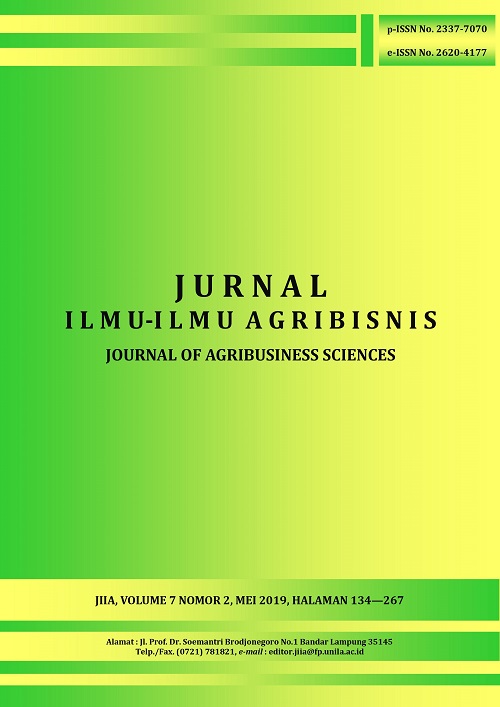HUBUNGAN TINGKAT PARTISIPASI ANGGOTA KELOMPOK TANI DENGAN DINAMIKA KELOMPOK TANI SERTA PENINGKATAN PRODUKSI PADI DI DESA CINTAMULYA KECAMATAN CANDIPURO KABUPATEN LAMPUNG SELATAN
DOI:
https://doi.org/10.23960/jiia.v7i2.3384 Abstract View: 1165
Abstract View: 1165
Abstract
This study aims to examine participation level of farmer group members, farmer group dynamics, rice production increase, and the relationship between the the participation, group dynamics and rice production increase in Cintamulya Village, Candipuro District, South Lampung Regency. Respondents in this study were 85 farmers. The study was conducted in August - September 2017. The research method used was a survey method using a quantitative descriptive analysis method. The relationship among variables are analyzed using nonparametric statistics Spearman rank correlation test. The results showed that the participation rate of farmer group members is in a low category, group dynamics is in less dynamic category, and increase production is included in a low category. There are significant relationships between the level of participation of members of farmer groups and farmer group dynamics, the level of participation and production increase, and group dynamics and production increase.
Key words: group dynamics, production increase, participation
Downloads
Downloads
Published
How to Cite
Issue
Section
License
Authors who publish with this journal agree to the following terms:
Authors retain copyright and grant the journal right of first publication with the work simultaneously licensed under a Creative Commons Attribution License that allows others to share the work with an acknowledgement of the work's authorship and initial publication in this journal.
Authors are able to enter into separate, additional contractual arrangements for the non-exclusive distribution of the journal's published version of the work (e.g., post it to an institutional repository or publish it in a book), with an acknowledgement of its initial publication in this journal.
Authors are permitted and encouraged to post their work online (e.g., in institutional repositories or on their website) prior to and during the submission process, as it can lead to productive exchanges, as well as earlier and greater citation of published work (See The Effect of Open Access).














